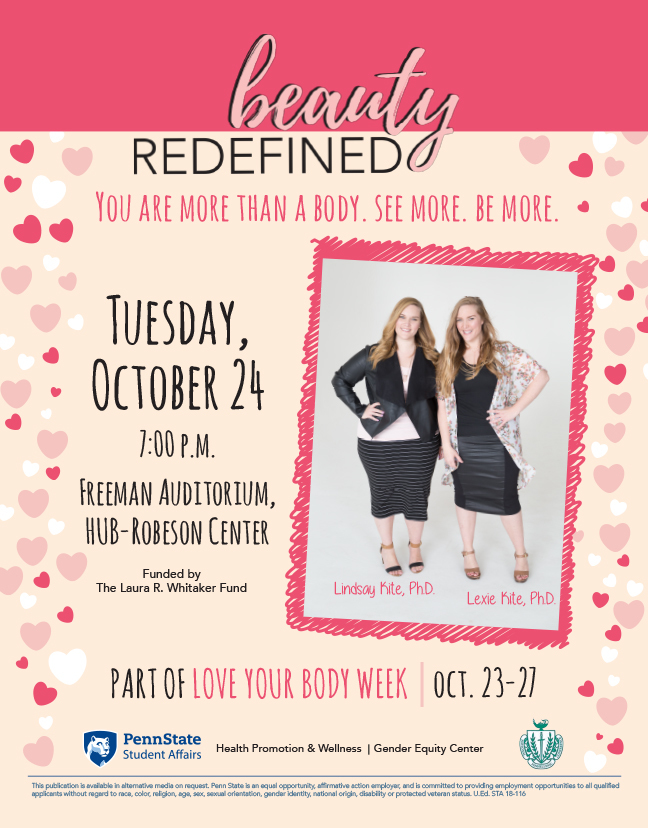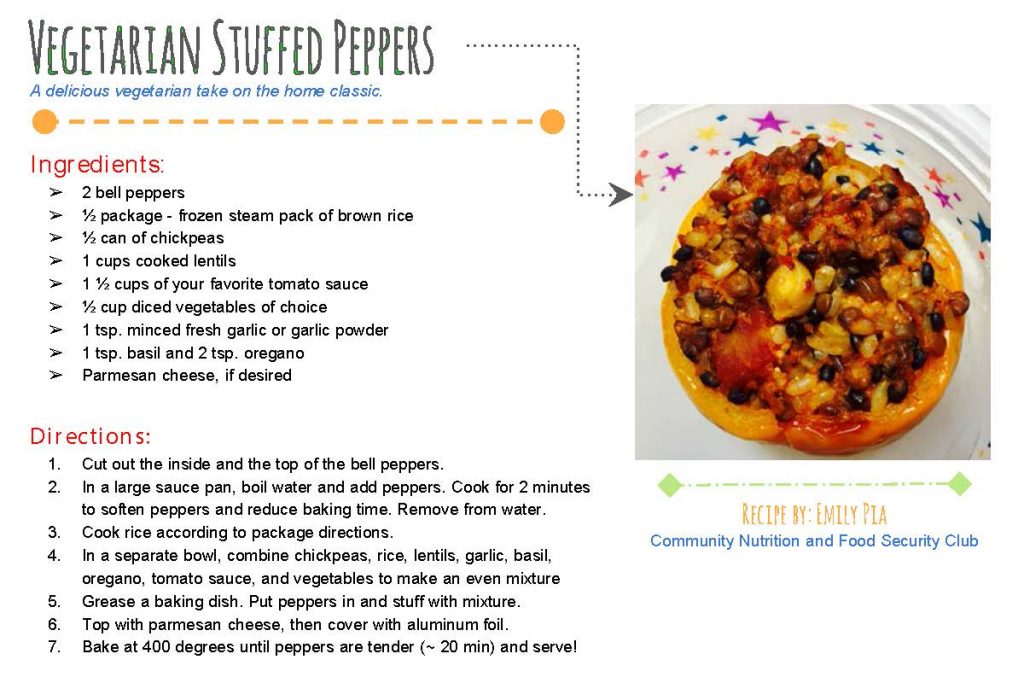Category Archives: 9 Dimensions of Wellness
Tofu Scramble
A protein-packed meal that you can eat for breakfast, lunch, or dinner!
Recipe By: Emily Pia, HealthWorks Peer Educator
Ingredients:
- ½ block firm tofu
- 1 Tbsp olive oil
- Chopped vegetables of choice (we recommend zucchini, peppers, broccoli, onions, mushrooms and tomatoes)
- ½ tsp minced garlic
- ½ avocado
- Salt, to taste
- ¼ tsp smoked paprika
- ¼ tso chili powder
- Hot sauce or sriracha, if desired
Directions:
- Drizzle olive oil and add garlic to a pan over medium heat on your stovetop.
- Add chopped vegetables.
- Squeeze tofu in your hands over the sink to reduce water content.
- Crumble into the pan.
- Add salt, paprika and chili powder to season and cook for 3 min.
- Serve with avocado and hot sauce/sriracha.
Rice, Chickpea and Spinach Skillet
An easy, inexpensive, and heaty 5-minute meal
Recipe By: Emily Pia, Community Nutrition and Food Security Club
Ingredients:
- 1 frozen steam pack of rice (10 oz.)
- 2 handfuls of fresh spinach (or ¼ package frozen spinach)
- ½ can of chickpeas (chickpeas and garbanzo beans are the same!)
- 1 Tbsp olive oil (or any type of cooking oil)
- 8 oz your favorite jarred or canned tomato sauce
- Parmesan cheese (if desired)
Directions:
- Cook frozen rice according to package directions (usually three minutes in the microwave).
- Drizzle olive oil in a pan over medium heat on your stove top.
- Add chickpeas, spinach, and ½ bag of rice to the pan and cook until spinach begins to wilt (put away the other half for leftovers!)
- Add tomato sauce and continue to cook until all is warm.
- Top with Parmesan cheese if you’d like, and serve!
Pasta and Veggie Bowl
Perfect for busy nights!
Recipe By: Teresa Lesher, Community Nutrition and Food Security
Ingredients:
- Pasta of your choice (try whole grain!)
- As many chopped vegetables of your choice (try broccoli, mushrooms, peppers or zucchini)
- Pre-cooked chicken, turkey, tofu or protein of choice
- Marinara sauce (look for a low sodium/sugar variety)
Directions:
- Bring water to a boil in a pot.
- Add pasta once water is boiling, and cook according to package directions.
- When pasta has 1-2 minutes left, add raw vegetables to pasta water.
- Once pasta is done, drain and top with protein of choice and marinara sauce.
Stay Active This Summer
Spring semester has come to an end and summer is approaching. For some students this means starting summer with an internship or a job. These exciting opportunities might also involve being sedentary for long periods of time. So what can you do to keep active during work hours? Here are some creative ways to stay active if you have an office job or internship:
- Change up your routine to work. If possible, instead of driving to work, walk or ride a bike. You’ll get fresh air and work those leg muscles. If you have to drive to work, try to park away from the entrance to get additional steps.
- Take the stairs. Skip the elevator and you’ll increase your endurance.
- Stand up instead of sitting down. Try changing up the work day by using a standing desk to do your work.
- Take calls while standing. If you have the opportunity to stand, do so while talking on the phone.
- Move around. Avoid sitting in the same exact position for an extended period of time. You can stretch your arms or round and then straighten your back several times. This will help increase blood flow.
Written by Michelle Szczech, HealthWorks member
Physical Wellness: What It Is, Why It’s Important, and How to Cultivate It
What does it mean to have Physical Wellness? Physical wellness means getting adequate sleep, eating a healthy and balanced diet, being physically active every day, and getting an annual medical check-up (1).
Why is Physical Wellness Important? Physical wellness is important because your body needs to be healthy so you can perform to the best of your ability in all areas of your life, including academically. Physical activity is just one aspect of physical wellness. It also includes managing your stress, getting enough sleep, and eating a healthy diet. Many college students struggle with getting enough sleep. Staying up late to cram for an exam or write a paper can be counterproductive because you will accrue sleep debt. If you are sleep-deprived, your memory will not be as good and you will not be able to learn efficiently or focus your attention. Also, sleep, stress and physical activity are all connected. If you are physically active, you will reduce your stress level and will probably sleep better as well.
How do you cultivate Physical Wellness? To cultivate physical wellness you must get adequate sleep (7-9 hours) every night (1). Aim for 30 minutes of moderate intensity exercise per day. Incorporate strength training and stretching into your exercise routine (5). You can achieve a balanced diet by eating at least 5 servings of fruits and vegetables per day (1 serving = about 1 cup), eating whole grains and, if you eat meat, make sure the protein is lean (e. g., fish, chicken). Limit saturated fats, but consider including more unsaturated fatty acids found in foods such as chia seeds, avocados, and salmon (6). Avoid consuming trans fats (6). In general, make sure to eat a variety of whole foods to get the most out of every meal (7).
Sources
- Ohio State University Student Wellness Center: 9 Dimensions of Wellness https://swc.osu.edu/about-us/9-dimensions-of-wellness/
- Harvard Health Publishing; Harvard Medical School: Importance of Sleep: 6 reasons not to scrimp on sleep https://www.health.harvard.edu/press_releases/importance_of_sleep_and_health
- UC Davis Student Health and Counseling Services: https://shcs.ucdavis.edu/wellness/physical
- U.S. Department of Health and Human Services: Why is Sleep Important? https://www.nhlbi.nih.gov/health/health-topics/topics/sdd/why
- U.S. Department of Health and Human Services: Physical Activity Guidelines for Americans https://www.hhs.gov/fitness/be-active/physical-activity-guidelines-for-americans/index.html
- Choose My Plate: Saturated, Unsaturated, and Trans Fats https://www.choosemyplate.gov/saturated-unsaturated-and-trans-fats
- Choose My Plate: USDA Food Pyramid http://www.foodpyramid.com/myplate/
Environmental Wellness
Environmental Wellness: What It Is, Why It’s Important, and How to Cultivate It
What does it mean to have Environmental Wellness? Environmental wellness is about having a connection with the earth. This means you actively work to preserve and protect the planet and help make it a clean and safe place to live (1). This includes protecting yourself from environmental hazards such as air pollution, ultraviolet radiation in the sunlight, chemicals, noise, water pollution, and second-hand smoke (2).
Why is Environmental Wellness important?
If the environment isn’t healthy, then humans and other creatures cannot thrive. Human beings have the greatest impact on the earth’s resources (e. g., air and water) than any other creatures. It’s up to us to make sure we’re engaging in behaviors that foster sustainability and are ecologically friendly. Also, having a healthy and clean environment contributes to your overall physical and mental health (2).
How do you cultivate Environmental Wellness?
Protect and preserve the environment by reusing and/or recycling paper, glass, plastic, and metal. Understand that natural resources are not limitless (2). Buy less stuff (e. g., clothing, electronics). Reduce trips in the car by walking, taking the bus, or riding a bike to work, class, and the store. Use natural cleaning supplies. Reduce your use of paper; don’t print things unless you need to. Make sure your living space is clean and free of the environmental hazards listed above.
Share examples of how you reduce your impact on the planet with #healthypsu
References
- UC Davis Worklife and Wellness: http://wellnesschallenge.ucdavis.edu/environmental.html
- University of California, Riverside Wellness: http://wellness.ucr.edu/environmental_wellness.html
Emotional Wellness
Emotional Wellness: What It Is, Why It’s Important, and How to Cultivate It
What does it mean to have Emotional Wellness?
Emotional wellness means having the ability to acknowledge, express, and cope with your feelings (1). You engage in self-care and stress reduction activities. You also have the inner strength to handle tough situations (2).
Why is Emotional Wellness important?
Being emotionally well and able to recognize and accept your feelings can make you more emotionally intelligent. This will also help you handle stressful situations. Emotional wellness is important because it can help you become more emotionally stable. You’ll also increase your inner strength and improve your self-worth and confidence in your ability to make decisions (2).
How do you cultivate Emotional Wellness?
Cultivating emotional wellness requires you to be positive and be true to yourself. To have emotional wellness, you must be able to accept your feelings and be comfortable expressing your emotions (3). To fully accept your emotions, you first have to be okay making mistakes and be able to learn and grow from your mistakes (3). Cultivating emotional wellness is not an easy task. Take small steps. Start by writing down your thoughts and feelings.
- Ohio State University, Student Wellness Center: https://swc.osu.edu/about-us/9-dimensions-of-wellness/
- UC Davis Student Health and Counseling: https://shcs.ucdavis.edu/wellness/emotional/
- University of California, Riverside: https://wellness.ucr.edu/emotional_wellness.html
Love Your Body Week October 23-27
HealthWorks is hosting Love Your Body Week at University Park October 23 – 27. The week-long series of events is designed to encourage students to appreciate, nurture and respect their bodies. Students will have an opportunity to participate in Love Your Body table events including: create your own affirmation cards for yourself or a friend; take a KIND bar to spread KINDness; and tell us what you love about your body while posing for a picture with the “Inspire Hope, Empower Change” Instagram frame. Handouts and information will be available at each table with tips to improve body image as well as other Penn State resources and giveaways. The Love Your Body tables will be on the ground floor of the HUB Monday 10/23 – Wednesday 10/25 from 11 a.m. – 2 p.m. Additionally, HealthWorks will have a Love Your Body table in the Intramural Building on Thursday 10/26 and Friday 10/27 focused on body positive reasons to exercise and ways to fuel one’s body. Tuesday night guest speakers Lindsay and Lexie Kite will share simple strategies for building body image resilience. They will share how the media and society are negatively impacting many people’s view of themselves and how we can counter the messages and improve our wellbeing. The Kite sister’s presentation will take place at Freeman Auditorium in the HUB, on Tuesday, October 24th at 7pm.
Tuesday night guest speakers Lindsay and Lexie Kite will share simple strategies for building body image resilience. They will share how the media and society are negatively impacting many people’s view of themselves and how we can counter the messages and improve our wellbeing. The Kite sister’s presentation will take place at Freeman Auditorium in the HUB, on Tuesday, October 24th at 7pm.
Eating Disorders
Eating disorders — such as anorexia, bulimia, and binge eating disorder – include extreme emotions, attitudes, and behaviors surrounding weight and food issues. They are serious emotional and physical problems that can have life-threatening consequences for females and males. In the United States, 20 million women and 10 million men suffer from a clinically significant eating disorder at some time in their life (NEDA).
Interested in learning more about eating disorders or do you want to learn proactive ways to foster a body positive environment? Visit the websites below:
- nationaleatingdisorders.org
- eatright.org
- feast-ed.org
- eatingdisorderhope.com
- womenshealth.gov/body–image
Are you or someone you know struggling? There is a team of providers at Penn State who are dedicated to helping students who are struggling with eating disorders. Use the information below to make an appointment.
Healthy Eating and Living Support (HEALS)
University Health Services (UHS) Medical Appointments 863-0774
Nutrition Clinic 863-0461
Counseling and Psychological Services (CAPS) 863-0395
